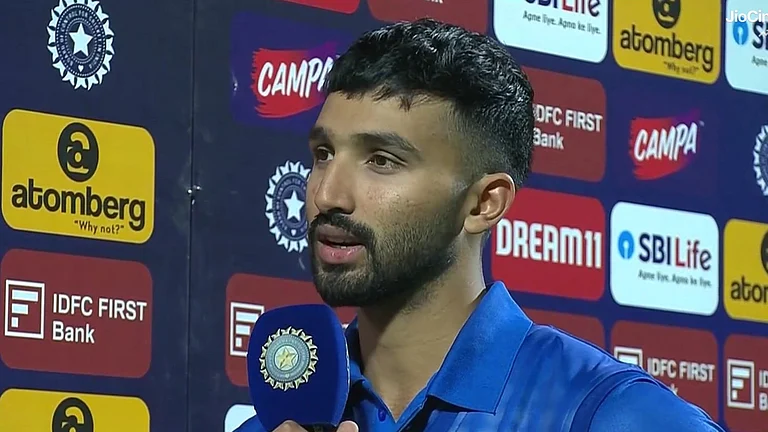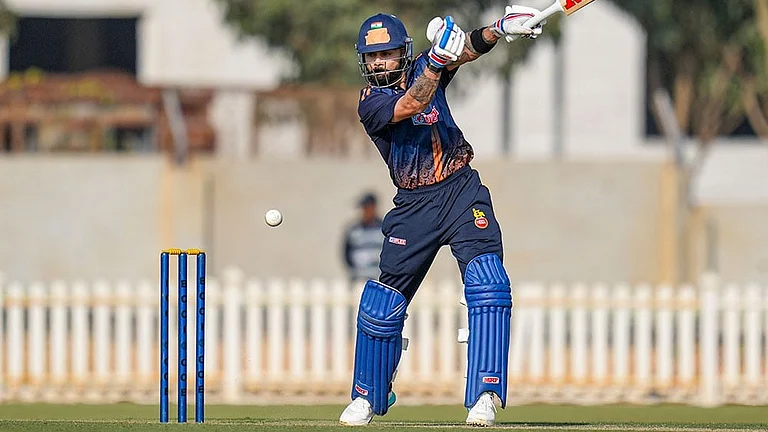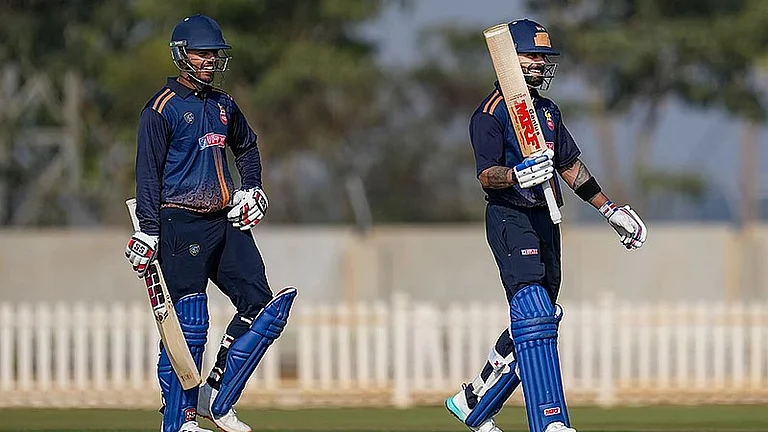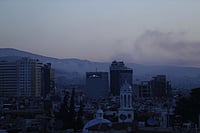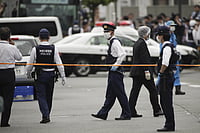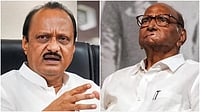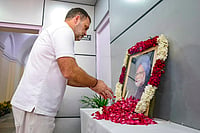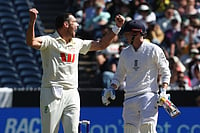Diwali in London brought Tony Rajya if not Ram Rajya. Those hours of waiting in that deliberate semi-dark at Alexandra Palace in London to symbolise vanvas before Tony Blair arrived. And then there was light. And the couple of thousand or so Indians gathered in the hall could finally see one another. Those uninitiated in symbolism also saw a couple of shrubs being moved off stage. It was all about building tolerance and understanding, the Hinduja way.
That it was not about tolerance alone was clear from the long wait for what Tony Blair's wife Cherie would wear. There were no disappointments here-it was an off-white salwar-kameez with some glitter embroidered on it. You don't wait to see any more if she will wear Indian. The question is what she will wear from what might well become her Indian wardrobe.
All eyes were on Cherie, but all minds should have been on building "tolerance and multi-cultural understanding in the new millennium". That is how the Hindujas billed the event. It was also what was written on a card given to guests in a sealed envelope to sign after Tony did (like the Hindujas, let's call him Tony just this once).
The event became an immediate test of tolerance of a quite different order. No chairs, no ventilation, almost nothing to drink while guests stood for three to four hours in that hall. One of them fainted and had to be taken away in an ambulance. The Hindujas and the vips sat on stage and watched the well-dressed herd stand and wait to take the pledge. To be fair, Srichand Hinduja apologised for keeping them standing, before he sat down again.
For Srichand Hinduja, who says more things spiritual than the three other brothers put together, this was another of those events mixing politics and the "spiritual"-a word Srichand uses with alarming ease. The politics was clear. But how did the Hindujas do their things spiritual?
Guests passed through what was called a "tunnel of darkness" to arrive in the main hall at Alexandra Palace in north London. The 20-yard tunnel was quite bright really, with hundreds of twinkling lights and a large red lamp at the end to symbolise emergence into light.
But there wasn't light at the end of the tunnel. Guests stepped into hours of standing and waiting in an eerie purple-green light to give the forest effect. The vanvas in the hall ended with the arrival not of Rama but of Blair when the lights were switched on and everyone looked human again.
Tony walked to the stage not to bhajans but to an instrumental version of "Tum paas aaye, yoon muskuraye, ...kuchh kuchh hota hai". Surely the DJ was saying something in song. Because when everyone was waiting, it was that old Kishore song "Mana janaab ne pukara nahin..."
If you still have doubts, how about this one for the vanvas scenes from Hare Rama Hare Krishna: "Dekho O diwano tum ye kaam na karo, Ram ka naam badnam na karo". This was the big evening for symbolism from the brothers. Maybe there was something in those other songs too. "Mere khwabon mein jo aaye", "Dil kya kare jab kisi se" Hinduuu-jas, I love you.
Art hung heavy over guests that evening. Once you could see you saw a huge octopus-like balloon hanging from the roof. This was the sun. And the lights showed up giant posters of a dozen M.F. Hussain paintings strung from the ceiling. They competed in size with two giant screens to show the close-circuit TV picking the arrival of Tony and the rest, and providing the first glimpses of what Cherie wore.
The stage show was hosted by Sir David Frost, famous for the bbc programme Breakfast With Frost, who conducted proceedings with more style than accuracy. The Hindujas were often simply the "Hindus". They did not seem to mind. Once on stage, there were other effects. A loud blast, the showering of confetti, and Blair made his speech in which he spoke for multi-culturalism. He also expressed his condolences for those who died in the Orissa cyclone-something the brothers failed to do.
S.P. Hinduja initiated the millennium pledge but with the announcement that in the Hindu calendar it is the year 2056, and that the East is therefore always ahead. An example, he said, was "the Indus Valley civilisation from where our family originates which is in its ninth millennium".
He spoke of the family's spiritual ventures at some length. He said, "All over the world, people need a change, they need something that removes mental and cultural barriers. And so we decided to have this event of the festival of lights and signing of the pledge."
More SP-speak: "Our family has a philosophy that whenever we initiate a good cause, we do it collectively so that there is involvement of all the communities. Whether we are helping the Leprosy Foundation or the Victoria and Albert Museum, whether we are helping in health, education, culture, we speak not just for the Hinduja Foundation but for everyone."
The brothers addressed a press conference earlier where they delighted photographers with frames of all four and just four. There were no questions raised on Bofors, not after that stern announcement: "We will not allow any question on the Hinduja business interests. There can be questions only on the event itself and on the millennium pledge."
And so Hinduja was asked questions at the press conference in his capacity as a spiritual seer. One of them was how he sees Britain 100 years from now. After a pause, S.P. Hinduja replied: "It will be more and more Asian." He went on to add: "Because the Asians have been maintaining very good heritage. Their historical relations, connections and cultural understanding is better than the Americans'. I also find a lot of initiative of tolerance and understanding. But Britain will be multi-cultural rather than only Asian."
SP (and why not) expressed much faith in India with the observation: "Now the Cold War is over. The end has shown that the international community has supported India. It is clearly indicating that now it's only free market globalisation."
The Hinduja mission is to "promote that all cultures have the same message and there is more commonality than difference," SP said. "For the last 2,000 years, we are only aware that we have differences. We need to change the approach to life. My approach has been how to change perspective on commonality rather than differences that lead to conflict." To that end, he said, "this event is a good start".
The Hinduja plan to that end was for guests to sign a card carrying the "millennium pledge" which read: "I/We pledge my/our enduring support to build tolerance and multi-cultural understanding in the new millennium." Guests were asked to open the card after the arrival of Blair, sign it and drop it in baskets around the hall.
As guests left, the baskets seemed mostly empty. Building tolerance isn't that easy.







